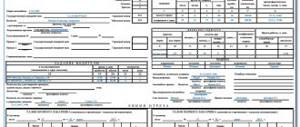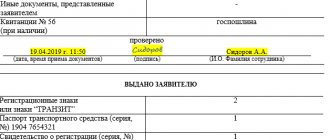A waybill
is the main primary document for recording the driver’s work, mileage, and vehicle route, issued daily to vehicle drivers.
The waybill form refers to the primary documents used in the process of accounting for cargo transportation. The waybill together with the bill of lading form (TTN) are documents characterizing the work of the driver and the vehicle. Both documents serve as the basis for calculating and paying wages to the driver, as well as for calculating the cost of goods transportation services. In 1997, two forms were approved, which are still used for the operation of freight vehicles in Russia.
Why do you need a waybill?
Waybill form 4-c is used for cargo transportation based on piecework wages (the driver completed the trip - handed in the waybill). Waybill form 4-p is used when a temporary tariff is applied. As a rule, this form takes into account the driver’s work during one work shift (one day). At the same time, he can make several flights of the same type for one customer, or two flights for different customers.
The waybill consists of the main part and a tear-off coupon. The tear-off coupon of the form is filled out directly by the customer. The data specified in it serves as the basis for issuing an invoice for work performed by the carrier. The tear-off coupon is an integral part of the invoice and serves as confirmation of the accrued amount for the services of the cargo carrier.
The main part of the waybill form is an accounting document and remains with the carrier. This part of the waybill must contain duplicate data on the time during which the cargo carrier’s vehicle was used and the length of the cargo delivery route. It also reflects data on the forced downtime of the vehicle, the need for additional operation of the vehicle engine and the implementation of work related to the use of equipment installed on the vehicle. It is these data that serve as the basis for calculating the operation of a given vehicle.
If time-based payment is assumed for the road transportation of goods, then the number of each consignment note, which is attached to the waybill, is indicated on the waybill. A copy of the waybill (BW), attached to the waybill form, serves as confirmation of the work performed. Upon completion of the work, records are made and an entry is made in the waybill register, and the total total (in tons) of transported cargo is calculated. Based on the aggregate indicators, the hours of use of the vehicle and the driver’s salary are calculated.
Before the driver starts work, the main part of the waybill form must be filled out by the cargo transportation dispatcher, or the person replacing him. Subsequent entries in the waybill are made by employees of the cargo carrier organization, as well as by the customer (or his representative). The driver does not have to make any entries in the waybill. He signs the waybill only when he accepts the car for work and returns it at the end of the shift. The driver receives waybills from the dispatcher at the beginning of the work shift, and their receipt is certified by a signature. At the end of the work shift, he is required to hand over the waybill. This document is issued only for one work shift or work day. The driver can receive a new waybill only after he hands over the old one to the dispatcher and thus closes the working day.
The sequence of issuing a waybill for a car according to Form 4-C
Write-off of fuel and lubricants in the form of expenses for servicing a truck and recording the driver’s salary is carried out in a standard inter-industry form 4-C. It is this that traffic inspectors require to present along with other documents. The pre-trip medical examination inspector, mechanic, fuel attendant, dispatcher and car driver must make their marks on the sheet.
The form is registered in the appropriate journal, the date of completion is written on the front side and a stamp is placed (the stamp has been canceled since 2019). It is assigned an individual serial number. After the driver has handed over the previous waybill, he is given a new one against receipt. In addition to this, the driver also receives waybills if he is transporting material assets.
During the journey, the document is kept by the driver so that, if necessary, it can be presented to the traffic police inspector upon request. The voucher contains 2 tear-off coupons, which are filled out and received by the customer along with an invoice for payment. At the top of the front part of the 4-C waybill, the company details are indicated (legal address, name, title, OKPO code and telephone number). Filling out the sheet is regulated by Resolution No. 78.
How to correctly make entries in the travel form
The order of filling out the columns of the waybill is strictly regulated. Filling occurs as follows:
- The date (day, month and year) is indicated under the name of the document, which must correspond to the date entered in the registration journal for the issuance of travel documents;
- Next comes a line in which the work code should be indicated. It is this code that serves as the basis for calculations and payment of wages to the driver;
- The columns “Brigade” and “Column” reflect the numbers of the vehicle fleet units to which the truck or the driver himself is assigned;
- The “Vehicle Data” column must contain data on the make of the car, its registration numbers (state and garage);
- Lines containing official and personal information about the driver must be filled in with the following data. This includes the driver’s surname and initials, his license number, his personnel number assigned according to the organization’s staffing table, as well as the driver’s class;
- If transportation of cargo requires a license, then you must fill out the column with information about the license card. This column indicates the series and number of the card, as well as its type. By type, license cards are divided into limited and standard;
- The “Trailers” column must contain the state and garage number of the semitrailer or trailer, as well as the brand, if the use of these means is necessary for the cargo transportation process. If trailers are expected to be replaced during cargo transportation, then their numbers and brands are entered directly on the spot;
- The column “Accompanying persons” must contain information about the persons who accompany the driver when transporting cargo. These persons can be trainees, forwarders, loaders. This column contains the surname and initials of employees, as well as the documents on the basis of which they carry out their work;
- The column “Work of the driver and the vehicle” must contain information about the time of departure of the vehicle from the territory of the motor transport enterprise and the time of its return to the territory of the vehicle fleet;
- In the column “Assignment to the driver”, the freight dispatcher or other person enters the address of the customer’s location, at whose disposal the driver with the vehicle is placed;
- The column “At whose disposal” requires the customer to indicate the person with whom the driver will specifically contact while performing the work. Often this is the customer himself, but this person can be a trusted representative of the client. The authorized person carries out his duties on the basis of a power of attorney. It is best to attach a copy of the power of attorney to documents (waybills and waybills);
- The “Arrival time” line must contain data, indicated in hours and minutes, about the time of arrival of the vehicle at the customer’s location to perform one-time work. If the services under the contract involve the completion of work over several days, then the time is recorded in this column according to the schedule specified in the contract;
- The address columns for the loading and unloading point (No. 20-21) must reflect the actual addresses of the point of loading of goods and the point of delivery (unloading) of goods;
- The line “Name of cargo” contains the full name of the goods intended for transportation;
- The line "Number of trips with cargo" should reflect the required number of trips required to complete a particular task. The task is determined in the application or in a single order;
- The “Distance” column contains data on the length of the route. Kilometers can be determined from data from road organizations or a map of the city (region). You can also use data from previous cargo transportation. Kilometers can be calculated on any transport exchange operating on the Internet, for example ATI.SU. As a rule, the data provided by transport exchanges is quite accurate, and the mileage calculation service is absolutely free;
- The column “Transport tons” contains data on the amount of cargo in tons that needs to be transported.
Any changes to the waybill regarding the driver’s assignment may be made only by an employee of the motor transport organization that owns the vehicle. In case of agreement between the parties (carrier and client), this can be done by a person authorized by the customer or by the customer himself.
On the front side of the waybill form there is a column “Issue fuel”, which indicates the amount of fuel required for the operation of the vehicle. The amount of fuel required is entered in the column in words, taking into account unused fuel over the past day. The completely filled out sheet by the dispatcher is certified by his signature. Thus, the dispatcher certifies the correctness of completion and reliability of all entered data, including the fact that the driver has a driver’s license.
Procedure and rules for filling out 2021
Resolution of the State Statistics Committee of the Russian Federation No. 78 of November 28, 1997 provides for established, but not mandatory forms for certain categories of vehicles: for passenger cars - forms No. 2, 3-special; for taxi – No. 4; for buses carrying passengers - No. 6, 6-special. Correct execution of a truck waybill is provided according to forms No. 4-C, 4-P.
Order of the Ministry of Transport of the Russian Federation No. 152 dated September 18, 2008 establishes the rules for filling out.
The following details must be available:
- Name and number of the document. The title must be formatted according to the type of vehicle (car, truck, tram, etc.). The number is placed next to the title in order corresponding to the chronology of the numbering system established by the head.
- Validity. The start date of maintenance and the period of use of the document are indicated. As a rule, it is one-day. The total period of use should not exceed one month.
- Information about the vehicle category. The type of vehicle and make, presence or absence of a trailer, state license must be reflected. car sign, mileage, date and time when the car left for the flight and returned to the parking lot, odometer data readings.
- Information about the owner of the vehicle. The name, form of organization, address and telephone number of the enterprise are indicated. Individual entrepreneurs enter their personal data - full name, telephone number, postal address.
- Driver details. Full Name. Marking the result of the medical examination, as well as the time of its completion before boarding the flight.
When a car is used by several drivers, it is allowed to issue two vouchers for one vehicle.
Each document separately for one of the drivers. In such a situation, the mileage and departure time are indicated by the driver who left the parking lot, and the information upon return is indicated by the one who last returned to the garage. The document is drawn up for all vehicles used for passenger and cargo transportation.
The title must contain the stamp and seal of the enterprise or the personal seal of the entrepreneur who owns the car.
The time of leaving the garage, the time of return of the official vehicle, and the speedometer readings are noted by authorized persons appointed by internal management order. The information must be certified by the signature of responsible employees and sealed. If the director of a company or an individual entrepreneur himself takes on driving a car, combining management with a driving position, such certification is not required.
The medical professional enters the date, time and results of the medical examination into the document. And it is also certified with a personal signature with initials and a stamp.
The storage period for transport accompanying documentation is 5 years.
The responsibilities of the vehicle owner include registration of vouchers in the logbook.
It is allowed to add additional details that reflect the distinctive features of the official activity (names of the type of cargo, passenger transportation, etc.).
The document is filled out on both sides - back and front.
Sequence of filling out the front side:
- The company stamp is affixed at the top, number and series, the date is slightly lower.
- Just below is written the name, address and telephone number of the organization, registration code.
- The next step is to fill out information about the vehicle and its characteristics.
- Further, driver data – full name, personnel number, driver’s license data.
- A special section about the license card is filled out by some organizations. For example, taxi drivers.
- A separate section indicating the speedometer readings, remaining fuel and the technical condition of the car is filled out by mechanics.
- Upon completion of filling out, personal tasks are determined for each employee and the vouchers are transferred to the driver.
If necessary, marks are made about lateness or idleness of workers.
The reverse side is intended for drivers. It marks the process of completing tasks. The place and time of departure and arrival, the mileage traveled are indicated and this is secured with the driver’s signature. The number of hours worked and kilometers traveled per day is displayed at the bottom of the document.
Depending on the payment system at the enterprise, salaries are calculated based on the completed data, and then transferred to the accounting department.
Features of filling on line:
- The time must be entered with an exact indication of the hours and minutes at the moment when the paper is shown to clients.
- In the “Customer” column, clients must put their signatures, confirming the veracity of the information.
- Customers fill out the arrival and departure columns by taking readings from the speedometer.
- Clients can leave their comments in the “Special notes” line.
When returning the car to the garage, the mechanic fills out the work section - here the exact time of return is written down to the minutes, as well as fields about the remaining fuel and speedometer readings. The accuracy of the information is confirmed by the mechanic’s signature.
The driver signs opposite the line “Passed”, and the mechanic signs “Accepted”. The dispatcher is the final authority; he signs and enters the ticket in a special journal.
For a clear example of how to correctly draw up a waybill for a passenger car, a sample can be easily found on the Internet.
How to fill out a waybill before leaving the garage
There are not many columns to be filled out in this part of the sheet. Following the recommendations, filling out this form is often quite simple.
- The columns related to the section “Fuel Movement” are filled out by the tanker or fuel and lubricants technician. These columns record data on the fuel actually received to carry out the work;
- The front side of the travel document form must contain a note about the medical examination. A medical examination is a mandatory procedure before the start of cargo transportation work. Only an officially authorized person with a medical education performs a medical examination and fills out the necessary columns of the waybill. The purpose of the medical examination is to determine the driver’s health status and his ability to drive a vehicle;
- Before the vehicle leaves for the line, a specialist from the technical control department or checkpoint must record data from the car’s speedometer and enter this information in the “Speedometer readings” column. The column is located in the “Car and Driver Operation” section;
- These same specialists reflect the time the car left the line. The time is recorded in the “Actual time” column. It is possible to enter data either manually or using a stamp. Sequence of data indication: date, month, hours and minutes;
- Another column related to the “Fuel Movement” section reflects the remaining fuel in the vehicle’s tanks when leaving the route. This data is recorded by the fuel and lubricants mechanic in column No. 12 of the waybill;
- The waybill form contains lines that reflect the actual condition of the vehicle (its suitability for work, technical notes and recommendations). This section is filled out by a quality control mechanic and indicates the vehicle’s readiness for work, and also serves as permission for the driver to leave. This section is certified by both the mechanic and the driver’s personal signature.
How to fill out a waybill on the route
Consider the procedure for filling out the travel form using the example of form No. 4-c.
- Column No. 27 contains information about the numbers of all flights made. This is necessary for subsequent sorting of all attached delivery notes;
- The next column must contain the numbers of all waybills attached to the waybill;
- Data on the date and time of provision of the waybill form to the consignee or sender are entered in columns No. 28-30. This occurs if a checkpoint is provided on the territory of the customer or consignee. Otherwise, these columns are not filled in, and the data is entered in the corresponding lines of the consignment note;
- Columns No. 39-40 contain the full name of the shipping organization. Data about the shipper (name and details) are certified by the signature of the shipper or an authorized representative, and also certified by a seal;
- If any unforeseen circumstances arise that cause downtime, in this case the line “Downtime on the line” is filled in. The data is entered by the appropriate specialist (technical assistance employee) or any other authorized person. The column must indicate the reasons for the downtime, the date and the exact time period during which the vehicle was idle. Data on downtime is certified by the signatures of the persons who filled out this column;
- On the front side of the waybill there is a section “Special notes”. It contains data that is not included in the waybill: comments and refusals of the customer to carry out work or vehicles, comments from traffic police officers and road service specialists.
Purpose
The paper must be completed not only because of legal recordkeeping requirements, but also because the form contains important information. It contains the technical features of the vehicle, the last service and refueling. Also information about the driver, his flight and time of work.
Based on this data, the accounting department calculates wages, so it is important to fill out each item correctly. If there are errors in it, it can be declared invalid. All items must be filled out in accordance with the data specified in the vehicle documentation. You can find an example of filling out a truck waybill on our website and make your own by analogy.
Rules for filling out a waybill when returning to the car park
After the vehicle returns to the garage, filling out the waybill form continues. The following data is entered into it:
- The first step is to fill out the “Works of the vehicle and trailers” section. This includes data on the flights made, the amount of fuel consumed, the time spent performing work, as well as the actual mileage during the shift;
- The “Fuel Movement” section contains lines about the remaining fuel, which are filled in by the quality control mechanic. The fuel and lubricants technician confirms the actual delivery of remaining fuel by the driver;
- After handing over the vehicle (the condition is recorded by the quality control department mechanic and is determined as satisfactory or unsatisfactory), the driver puts a mark in the “Passed” column, which is certified by the signature of the quality control department mechanic.
What are the requirements for filling out the 4-C waybill?
There are two types of truck waybills: form 4- C and 4-P. The difference between them is that Form 4-C is used when the driver’s wages are calculated on a piece-rate basis. The head of the company that owns the car and the officials who are responsible for the safety of its operation are responsible for the correct completion of this document.
The form does not have a strict, state-approved form. Meanwhile, if the contents of the voucher are incorrect, it is considered invalid. A serious mistake is the absence of at least one of the following items: the date of filling out and issuing the sheet, the stamp of the company that owns the truck (the stamp has been canceled since 2021) and the seal of the organization that owns the truck.
Working with the waybill after the driver has handed it over to the freight dispatcher
After the vehicle has been returned to the fleet and the waybill has been filled out by all services, the driver hands it over to the dispatcher, who continues filling it out.
- The section “Operation of the driver and the vehicle” is completed first. The following data is entered in the “Zero mileage” column: mileage from the gate of the motor transport enterprise to the loading point, and from the unloading point to the garage;
- The section “Fuel Movement” is quite extensive; several lines need to be filled in here. “Normal change coefficient” contains information about the general standard for changes in fuel consumption. This coefficient is associated with changes in fuel consumption rates. Lines about the operating time of special equipment and engine operation are filled in based on documented data. This includes data on the use of special equipment and its operating time, as well as data on additional engine operation (during loading and unloading operations, for example). This information must be entered into the waybill to determine the fuel consumption rate. After filling out the appropriate fields, the dispatcher certifies them with his signature;
- The section “Sequence of task completion” is the final stage. The dispatcher enters the total number of completed flights. The entry is made in the final line of column No. 27. The line “Transportation documents in quantity” reflects the total number of delivery notes handed over by the driver. Confirming the number of documents accepted and handed over to the dispatcher, the driver puts his signature in the “Submitted by the driver” column, and the dispatcher also signs in the “Accepted” column.
Return to base
Having returned back to the base, the driver submits all reporting documentation to the dispatcher, who checks that it is filled out correctly. Based on the data provided, the total mileage, fuel consumption and travel time are calculated. Based on the data provided, the driver is paid a salary.
If there were some breakdowns, then the dispatcher enters the relevant information in the “Notes” column: what happened, the cost of repairs, funds spent on spare parts.
After checking the documents, the driver signs that he has handed over the vehicle and fills in the following fields:
- No. 12 – period of equipment operation;
- No. 13 – motor operating time;
- No. 24 – numbers of completed trips in order;
- No. 25 - No. TTN;
- No. 26 – time spent on vehicle operation;
- No. 27 – transported amount of cargo;
- No. 28 – completed work;
- No. 29 – information about the shipper is recorded.
The data entered in these columns is confirmed by the signatures of the dispatcher and driver.
After all the manipulations, the document is handed over to the taxi driver, who calculates the cost of the trip. The final signature is given by the accountant after the inspection.
Thus, there is nothing difficult in filling out the travel sheet. A correctly completed document will not create unnecessary problems in the future. The main thing is to follow the instructions and the order of filling it out. The presented example of filling out a document will help you understand the sequence of filling it out.
How to correctly fill out the travel document form No. 4-p
The form of the waybill of this form is slightly different from the previous form No. 4-s. The section “Assignment to the driver” differs in its filling features. This section must be filled out by the dispatcher according to the data submitted in the application or one-time order of the client.
- Column No. 18, reflecting at whose disposal the driver with the vehicle comes, must include information about the client (name of his organization and location of the work site);
- Lines No. 19-20 reflect the time of arrival of the vehicle to perform work, as well as the time of departure;
- Column No. 21 contains data (in hours) on the approximate time allotted to complete the necessary work;
- Line No. 22 contains data on the required number of flights.
The tear-off coupon of the waybill form is filled out only by the customer. After this, it is handed over to the driver, who submits it along with the waybill to the accounting department. Based on the tear-off coupon, the customer is issued an invoice for the work actually performed, which he must pay. Filling out the tear-off coupon must also occur in accordance with the rules.
The driver presents the customer with a waybill. The customer, based on the data of this waybill, enters the number of the waybill and the date of its issue in certain sections of the tear-off coupon. Also included here are the details of the cargo carrier company, the brand and state registration number of the vehicle that arrived to perform the work.
The “Customer” line must contain the full name of the customer organization and the details of the official authorized to manage the arriving vehicle. Also in the tear-off coupon, the time of arrival of the vehicle and the time of its departure are entered in the corresponding columns. The customer fills out the column “Attached shipping documents”, which indicates the actual quantity and numbers of documents. One copy of each TTN must be attached to the travel document form.
The tear-off coupon contains information about the trips actually made by the driver; the corresponding column is filled in by the customer. Upon completion of filling out all the necessary information, the customer (or his authorized representative) certifies all entered data with his signature and the seal of the company.
Formal and actual responsibility for errors made when filling out the waybill form falls on the head of the enterprise (both the cargo carrier and the customer) or persons authorized to carry out this work. This includes both technical personnel responsible for the operation of vehicles (QD mechanics or gas station attendants) and persons whose responsibilities include filling out waybills (freight dispatchers).
Truck waybill sample filling
Let's look at an example of how to fill out a waybill.
Front side
The company puts its company stamp on it. The document must have a number, which is determined when registering it in a special journal, as well as the date it was completed.
Next, you need to indicate the name of the company, its address, telephone number, and OKPO code.
If necessary, fill in the code with the mode of operation, columns, and teams. Next, indicate the make and type of the truck, its state number, and garage identifier.
Full name is written below. the driver, his personnel number and details of his driving license.
If a trailer is used for transportation, then similar information is filled in for it in the appropriate fields as for a car.
The first table on the right records data on the work of the driver and transport. Here the planned and actual date and time of departure and arrival, as well as speedometer readings are entered. The following columns indicate the type and code of fuel used, the amount of fuel filled, as well as at the beginning and end of the day. In the same table you need to reflect information about the operating conditions of the machine (coefficients) and the special equipment used. This data is endorsed by all responsible persons.
Next, the dispatcher fills in information about the task that the driver must complete. It includes the name of the company that will have the vehicle at its disposal, the address and delivery time, the type of cargo being transported, the number of riders, mileage, and tonnage. After this, the responsible person determines by calculation the amount of fuel required and writes it in the appropriate line, confirming the data with his signature.
Before leaving for the line, the medic must examine the driver and put a stamp on the permit.
The mechanic checks the technical condition of the car when leaving and returning. The transfer of the car from him to the driver and back is carried out by transfer signatures.
In the “Special Notes” section, information is entered about the accident that occurred, about the training carried out by the traffic safety inspector, repairs, etc.
Reverse side
On the reverse side, the driver or representative of the customer organization makes notes about the progress of the task: what time and where the car arrived, the number and numbers of accompanying documents. It is advisable to certify all this data with the seals and signatures of the responsible persons of the counterparties. The table is endorsed by the dispatcher and the driver.
Downtimes that occur are noted below. Data about the cause, type, duration of it are recorded, and the signatures of the responsible persons are affixed.
In the lower table, the dispatcher enters the results of fuel consumption calculated when applying standards and based on the fact of fuel use. Next, the operating time of the machine is indicated with a breakdown by type of period. The following columns indicate the number of rides and entries into the garage. The mileage traveled by the car is determined; if there was a trailer, then that too. Here the total mileage and with the load are indicated.
Data is entered on the amount of cargo transported by the machine and trailers, and the ton*km indicator is determined, on the basis of which invoices are issued to customers. This section is endorsed by the taxi driver.
Below, for reference, data on the codes of car brands and trailers is recorded and the indicator for the days of operation of the car is filled in.









